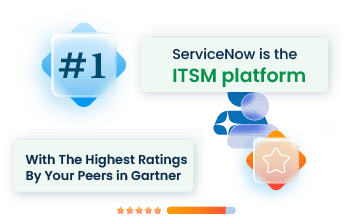ServiceNow Implementation Best Practices
Defining the Scope and Business Problem
Defining the scope and understanding the business problem are essential first steps in any ServiceNow implementation. Different roles within the organization will have unique perspectives and priorities:
- HR Managers: Focus on improving employee onboarding and service delivery processes.
- Executives and Business Decision-Makers: Aim to align the implementation with business goals and support overall growth and efficiency.
- Data Scientists and AI Specialists: Prioritize data requirements and ensure the platform supports advanced analytics.
- IT Directors and Managers: Emphasize integration with existing IT infrastructure for seamless operations.
Involve key stakeholders from each department to gather their input and understand their specific needs and challenges.
Developing a Project Plan
A comprehensive project plan is crucial for a successful ServiceNow implementation. Key steps include:
- Set Clear Objectives:
○ Define what success looks like for your organization.
○ Establish measurable goals and key performance indicators (KPIs). - Create a Detailed Timeline:
○ Break down the implementation into phases.
○ Assign realistic deadlines for each phase. - Resource Allocation:
○ Identify the necessary resources, including personnel, technology, and budget.
○ Ensure you have the right team members with the appropriate skills and expertise. - Risk Management:
○ Identify potential risks and develop strategies to manage them.
○ Plan for contingencies to address unexpected challenges. - Communication Plan:
○ Develop a strategy to keep all stakeholders informed.
○ Schedule regular updates and meetings to track progress and address issues promptly. - Tools and Templates:
○ Use project management tools like Microsoft Project, Trello, or Asana to organize tasks and track progress.
○ Leverage templates for project planning, risk assessment, and communication plans to streamline the process.
Selecting the Right ServiceNow Solution
Choosing the right ServiceNow consulting solution is crucial for aligning with your business goals and maximizing the platform’s potential. Here’s how to approach this important step:
- Understand Your Business Objectives:
○ Define your organization’s short-term and long-term goals.
○ Identify the specific problems you aim to solve with ServiceNow. - Involve Key Stakeholders:
○ Gather input from different departments to understand their needs.
○ Ensure the solution addresses concerns from HR, IT, Executives, and other teams. - Assess Current Processes:
○ Review existing workflows and processes.
○ Identify inefficiencies and areas needing improvement. - Research Available Modules:
○ Explore ServiceNow modules like IT Service Management (ITSM), HR Service Delivery (HRSD), and Customer Service Management (CSM).
○ Match these modules to your business needs. - Evaluate Scalability:
○ Ensure the solution can scale with your business growth.
○ Look for features that can expand or adapt as your organization evolves. - Check Integration Capabilities:
○ See how well the solution integrates with existing systems and tools.
○ Ensure smooth data flow and interoperability. - User Experience:
○ Choose solutions with a user-friendly interface.
○ Make sure the platform is easy to use for all employees. - Vendor Support and Community:
○ Assess the support provided by ServiceNow and its partner network.
○ Explore community resources for troubleshooting and best practices. - Cost-Benefit Analysis:
○ Conduct a thorough cost-benefit analysis.
○ Consider both initial costs and ongoing maintenance expenses.
Training and Stakeholder Collaboration
Effective User Training
User training is essential for a successful ServiceNow implementation. Different user groups need specific training to make the most of the platform.
- HR Managers and Staff: Focus on HR service delivery modules, showing how to streamline employee onboarding and manage service requests efficiently.
- IT Personnel: Cover the technical aspects, including configuration, customization, and integration with existing systems.
- Executives and Business Decision-Makers: Teach them to use ServiceNow’s reporting and analytics features to gain insights into business performance and make data-driven decisions.
- End Users: Offer simple, role-specific training sessions and materials like quick reference guides and video tutorials to ensure all employees can navigate the platform easily.
Use a mix of training methods, including in-person workshops, online courses, and interactive simulations, to cater to different learning preferences.
Engaging Stakeholders
Engaging stakeholders is crucial to ensure executive and team buy-in for the ServiceNow implementation.
- Executive Support: Communicate the strategic benefits of ServiceNow to top management. Highlight how it aligns with business goals, improves operational efficiency, and supports decision-making with robust analytics.
- Team Involvement: Involve key team members from the start. Gather their input during the planning phase and keep them informed about progress and changes. This fosters a sense of ownership and encourages active participation.
Platform Configuration and Customization
Configuring ServiceNow
Setting up ServiceNow to fit your organization’s needs is a key step in the implementation process. Proper configuration ensures the platform works well with your workflows and supports your business processes. Start by understanding your organization’s requirements. Talk to different departments to gather their specific needs and challenges. Use ServiceNow’s built-in tools and features to set up the platform. This includes configuring user roles, permissions, and workflows to ensure smooth operation across all levels of the organization.
Balancing Customization
Customization can enhance the functionality of ServiceNow, making it better suited to your organization. However, it’s important to balance customization to avoid complicating the system. Here’s how to customize effectively:
- Identify Necessary Customizations:
○ Determine which customizations are essential to meet your unique business needs. Avoid changes that add little value or could complicate future updates. - Use Out-of-the-Box Features:
○ Leverage ServiceNow’s out-of-the-box features whenever possible. These features are designed to cover a wide range of needs and are easier to maintain. - Plan for Scalability:
○ Ensure that customizations can scale with your organization’s growth. Design flexible and adaptable solutions. - Test Thoroughly:
○ Before implementing customizations, conduct thorough testing to ensure they work well with the existing configuration and do not introduce new issues. - Documentation:
○ Maintain clear documentation of all customizations. This helps with troubleshooting and ensures that future updates or changes can be managed effectively.
Ensuring Data Quality and Consistency
Maintaining High Standards
High data quality and consistency are crucial for the success of your ServiceNow implementation. Accurate and reliable data support effective decision-making and operational efficiency. Here are practical steps to ensure data integrity:
- Data Governance Framework:
○ Establish a framework that defines data policies, standards, and procedures. Outline the roles and responsibilities of data stewards and users. - Data Entry Standards:
○ Implement strict data entry standards to ensure consistency. Use standardized formats, mandatory fields, and validation rules to reduce errors during data input. - Regular Data Audits:
○ Conduct regular audits to identify and fix inconsistencies. Schedule periodic reviews to keep data accurate and up-to-date. - Automated Data Validation:
○ Use automated tools to validate data integrity. These tools can help identify discrepancies and enforce data quality rules automatically. - Training and Awareness:
○ Train employees on the importance of data quality and the procedures for maintaining it. Regular sessions can reinforce best practices and ensure compliance. - Data Integration:
○ Ensure seamless integration between ServiceNow and other systems. Use integration tools to maintain consistency across platforms and avoid data silos. - Monitoring and Reporting:
○ Set up monitoring and reporting mechanisms to track data quality. Use dashboards to provide visibility into data health and prompt corrective actions. - Backup and Recovery:
○ Implement robust backup and recovery procedures to protect against data loss. Regularly test backups to ensure data can be restored quickly in case of an incident.
Capturing Business Value with ServiceNow
Measuring ROI is essential to capture business value with ServiceNow. Start by identifying key performance indicators (KPIs) that align with your business goals, like reduced downtime, improved service delivery, and increased user satisfaction. Use ServiceNow’s reporting tools to track these metrics regularly. Show tangible benefits by comparing data from before and after implementation. Highlight cost savings from automated processes and efficiency gains. Share these findings with stakeholders to demonstrate how ServiceNow supports the organization’s success and growth. Regularly review and adjust strategies to maximize ROI and ensure continuous improvement.
Long-Term Success with ServiceNow ITSM Pro
Sustained Strategies
Ensuring long-term success with ServiceNow ITSM Pro requires sustained strategies. Continuously optimize workflows and processes to adapt to changing business needs. Regularly update the platform to take advantage of new features and improvements. Invest in ongoing training for your team to keep their skills sharp and aligned with best practices. Use analytics and performance metrics to identify areas for improvement and guide strategic decisions. Foster a culture of continuous improvement and innovation within the organization. Engage with the ServiceNow community and leverage resources to stay informed about industry trends and best practices.
Finding and Engaging a Certified Partner
Choosing the Right Partner
Selecting the right certified partner is crucial for a successful ServiceNow implementation. Look for partners with a proven track record of successful projects. Ensure they have extensive experience with ServiceNow and understand your industry’s specific needs. Check their certifications and expertise in various ServiceNow modules. Seek out client testimonials and case studies to gauge their reliability and performance. A good partner should offer a comprehensive approach, including planning, implementation, training, and ongoing support.
Benefits of Certified Partners
Engaging a certified partner brings many benefits to your ServiceNow implementation. Expert partners bring deep knowledge and experience, ensuring that the implementation follows best practices. They can customize solutions to fit your unique business requirements, reducing implementation time and minimizing disruptions. Certified partners provide valuable insights and recommendations, helping you make the most of the platform’s capabilities. They also offer ongoing support and maintenance, ensuring your system remains optimized and up-to-date. With their expertise, certified partners enhance overall project success and deliver a higher return on investment.
Common Mistakes and How to Avoid Them
Successfully implementing ServiceNow requires careful planning to avoid common mistakes. Here are some pitfalls and practical advice for success:
- Lack of Clear Objectives:
○ Pitfall: Not defining clear goals can lead to a lack of direction.
○ Advice: Set specific, measurable goals that align with your business objectives. Clearly define what success looks like for your organization. - Inadequate Stakeholder Engagement:
○ Pitfall: Failing to involve key stakeholders can result in resistance and lack of support.
○ Advice: Engage stakeholders early and keep them informed throughout the process. Their input and support are crucial for a smooth implementation. - Insufficient Training:
○ Pitfall: Poorly trained users can lead to underutilization and errors.
○ Advice: Provide comprehensive training tailored to different user groups. Ensure ongoing support and resources are available to help users make the - most of ServiceNow.
Ignoring Data Quality:
○ Pitfall: Poor data quality can compromise the effectiveness of the platform.
○ Advice: Implement strict data governance policies. Regularly audit and clean your data to maintain its accuracy and reliability. - Over-Customization:
○ Pitfall: Excessive customization can complicate the system and make it harder to maintain.
○ Advice: Use out-of-the-box features whenever possible. Customize only when necessary to meet specific business needs and ensure scalability. - Lack of Continuous Improvement:
○ Pitfall: Neglecting to review and improve the system can lead to stagnation.
○ Advice: Regularly assess the performance of your ServiceNow implementation. Use analytics to identify areas for improvement and make necessary adjustments.
Conclusion
To achieve ServiceNow success, start by defining the scope and understanding the business problem. Engage stakeholders and develop a detailed project plan. Ensure effective user training and collaboration. Configure the platform properly, balance customization, maintain high data quality, and implement a gradual rollout with continuous monitoring. Avoid common pitfalls by setting clear objectives, involving stakeholders, providing enough training, ensuring data quality, avoiding over-customization, and fostering continuous improvement.
Implement these strategies to fully harness ServiceNow’s potential. Engage certified partners for better implementation and continuous improvement. Explore ServiceNow’s resources for more guidance. Share your thoughts and experiences in the comments below!












